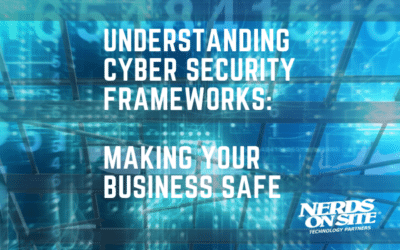Most businesses have a good idea of their organization’s biggest cyber security gaps. But there are a few that may surprise you. This blog post will discuss 8 of the biggest IT security gaps your organization may face. Keep reading to learn more!
1. Lack of employee training (Maybe?)
Made you look! We do not believe that employee training is the way to secure your organization. According to Verizon’s 2022 Data Breach Investigations Report, humans are responsible for 82% of the breaches that happen to companies today.
This breach data mainly includes medium and large-sized organizations with considerable IT budgets. The average IT budget for most companies in this bracket is 3.2% of its total revenue, with 10% going towards cyber security implemented policies and training.
With the average large company spending $20-$50million a year on IT, $2-5 Million is going to IT security measures. A considerable amount of this budget gets spent on employee education, and yet humans are still responsible for 82% of breaches.
At what point do we, the IT community, start to say that maybe training non-IT people to avoid advanced cyber incidents and cyber criminals is the way?
In 2022 systems and processes can nullify the need for employee training regarding IT security. Want to know what those are? Check out number 8 for more information.
2. Poor password management
One of the most common IT cybersecurity gaps is poor password management. 55% of people rely on their memory to manage passwords, and 85% of Americans reuse passwords across multiple sites, a number comparable to the rest of the globe (84%).
In 2021 alone, over 22 billion records exposed in 2021 via data breaches. This is 3x the population of earth. Granted, not all of these were passwords, but it was a good statistic to show much data is lost to cybercriminals every year.
You can check if your company has been part of any data breaches by heading to Have I Been Pwned and typing in your email. Doing this will show if your email account has been associated with any data breaches and if any of your information is currently available on the dark web.
What you can do
We’ve done passwords wrong now for over 25 years. Expecting a human being to memorize unique passwords for the hundreds of sites and applications we use is impossible.
The traditional alternative is to write those passwords down on your desk or computer, which isn’t secure either. Those passwords are now readily available to anyone who finds them in case of a break-in or a breach.
Instead, it would help if you had a password manager. A password manager software application allows users to store and organize passwords. Password managers typically require a master password to unlock the database. Even if your password manager is breached, the attacker needs your master password to access your passwords.
LastPass and 1Password are two popular password managers you can use to generate and store strong passwords for all your online accounts.
3. Lack of multi-factor authentication
Multi-factor authentication (MFA) is an IT security measure that requires users to provide more than one form of identification when logging into an account or system.
In most cases, MFA combines something the user knows (like a password) with something the user has (like a phone) or something the user is (like their fingerprint).
Despite its well-known benefits, MFA is not widely used & the lack of MFA is one of organizations’ biggest IT cybersecurity gaps.
The inconvenience of MFA is often cited as a reason why people don’t use it, but the truth is that the inconvenience is worth it. MFA adds an extra layer of security to your accounts and makes it much harder for attackers to gain access.
If you’re not using MFA, now is the time to start. Most online services are beginning to offer MFA, so there’s no excuse not to use it.
4. Admin Access For Everyone
Small businesses are particularly guilty of this.
A computer not assigned the correct administration permissions can be a significant security issue. Admin access should be limited to as few people as possible.
The problem is that if one person’s computer is compromised, the attacker now has complete control over the entire network.
In larger organizations, this IT security gap is often solved by limiting user access to devices and networks. One way to restrict user access is using the least privilege principle. This principle dictates that users only have the permissions they need to do their job and nothing more.
For example, users shouldn’t have write access if they only need to read files. If a user only needs to access a specific folder, they shouldn’t have access to the entire network.
Limiting user access is a good way to limit the damage if one of your devices is compromised. It’s also a good way to prevent users from accidentally causing harm.
The principle of least privilege is one of the most important IT security concepts every organization should use.
5. Not Keeping Software Up-To-Date
One of the most common IT security risks for proactive cyber security management is not keeping software up-to-date.
When new software is released, it often includes security fixes for vulnerabilities that have been discovered.
Your business is at risk if you’re not running the latest software version. Cybercriminals are constantly looking for new vulnerabilities to exploit and often target businesses running outdated software.
One way to close this IT security gap is to set up automatic updates. This way, you’ll always be running the latest software version, and you won’t have to worry about it.
One of the potential problems with automatic updates is that not all updates are tested fully and can cause problems with your system. Utilizing a Managed Service Provider like NOS with an update management policy will only deploy updates to your systems once they have been verified as problem free.
6. Lack of Cyber Insurance
Cyber insurance is a type of insurance that covers businesses in the event of cyber incidents.
The coverage varies depending on the policy, but it can cover things like loss of data, business interruption, legal costs, and more.
Cyber insurance is becoming increasingly popular, but there are still a lot of businesses that don’t have it. This IT security gap can be a costly one. If cyber attacks hit your business and you don’t have insurance, you’ll have to pay for all the damages out of pocket.
Cyber insurance is an important part of any IT security strategy, which every business should consider.
If you want to know more about cyber insurance, consider contacting The Mahoney Group.
7. The “It Won’t Happen To Me” Thought Process
Some companies with the worst cyber security practices have an “It Won’t Happen To Me” thought process.
Small-and-medium businesses are most guilty of this; often located outside of major cities, they believe that no one would ever focus on their business. The interesting thing about that thought process is they are correct, cyber threats probably won’t focus on their business, but that’s not what cyber attackers usually do.
Most breaches are a case of a cybercriminal casting a wide net, trying to get as many victims as possible in the hopes that some will be easy prey.
These cyber criminals don’t look on the map and see where you’re located if one of your team accidentally installs harmful software, clicks on a phishing link, or loses a password.
This is especially true for ransomware attacks, which are on the rise. In a ransomware attack, a cybercriminal will usually target millions of businesses globally, hoping that at least a few will pay the ransom.
Even if your business is small, you’re still a target. Don’t let the “It Won’t Happen To Me” thought process be one of your organization’s biggest IT security risks.
8. Using traditional network cyber security
Traditional network cyber security is categorized as firewalls and anti-virus software. IT security has come a long way in the past few years, but some businesses still rely on these traditional methods to protect their network.
While firewalls and anti-virus software are better than not having any protection, they’re not enough to protect your business from today’s cyber threats.
To close this IT security gap, you need to replace traditional methods with more modern and advanced solutions, like Zero Trust Networking.
Zero Trust Networking is a security model that doesn’t trust any user, device, or network by default. Instead, it uses advanced AI against dynamic allow and block lists to verify the identity of users and devices before granting them access to your network.
Through our Zero Trust networking solution, NOS currently protects over 3 million devices globally, and we’ve never had a single breach or ransomware event.
If you’d like to know more, don’t hesitate to contact us about our Cyber Security Services.
Conclusion
Closing the security risks in your organization can be a daunting task. Fortunately, it’s not as difficult as you might think. Many of the solutions are simple and affordable, and we can help you implement them.
Contact us today for a free consultation on IT security and how we can help close the biggest gaps in your organization.












